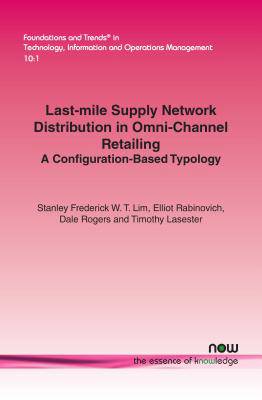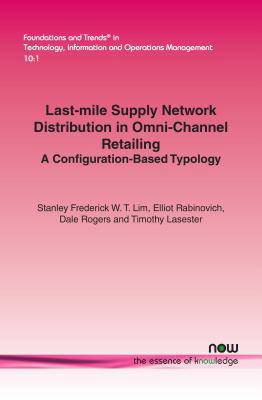
- Retrait gratuit dans votre magasin Club
- 7.000.000 titres dans notre catalogue
- Payer en toute sécurité
- Toujours un magasin près de chez vous
- Retrait gratuit dans votre magasin Club
- 7.000.0000 titres dans notre catalogue
- Payer en toute sécurité
- Toujours un magasin près de chez vous
Last-Mile Supply Network Distribution in Omni-Channel Retailing
A Configuration-Based Typology
Stanley Frederick W T Lim, Elliot Rabinovich, Dale S Rogers, Timothy M Lasester
79,95 €
+ 159 points
Description
Omni-channel retailing (OCR) strategies have recently emerged as a powerful engine of growth in the retail industry. The goal is to provide consumers with a seamless and consistent shopping experience across different channels and devices. Success in implementing OCR strategies depends on sophisticated compromises between fulfilment responsiveness and product variety across different product types, consumer segments, and shopping occasions. Failures in OCR strategies to optimize the trade-offs between responsiveness and variety are rooted in a poor understanding of how OCR strategies should build on last-mile supply network (LMSN) distribution configurations. Last-mile Supply Network Distribution in Omni-Channel Retailing: A Configuration-Based Typology addresses this issue by developing a typology of LMSN distribution configurations in OCR. Typologies are useful for four reasons: (1) they provide a mechanism for incorporating holistic principles of inquiry into organizational research; (2) they explicitly define patterns of constructs that determine dependent variables while enabling researchers to move beyond traditional linear theories; (3) they provide a means to incorporate equifinality; and (4) they establish connections between the findings of various studies. The existing literature covers a number of last-mile typological systems in the supply chain. However, these typologies do not provide a satisfactory characterization of various forms of LMSN distribution configurations in OCR and their unique structure, product/order and information flow, service architecture, and relational and governance aspects. To address these deficiencies in the literature, this typology updates the linearly "chain-centric" extended supply chain models developed previously and provides a framework that integrates multiple theoretical domains and terminologies that have been used disjointedly to describe the various forms of LMSN distribution configurations in OCR. After an introduction, Section 2 presents a review of the literature. Section 3 describes the methodology used to identify the different configuration dimensions and provides definitions of the terminologies. Section 4 describes the LMSN configuration-based typology while Section 5 presents LMSN evolution patterns through the discussion of example cases. Section 6 highlights key insights derived from the typology, elaborates on academic implications, and suggests some research extensions. Section 7 discusses the managerial implications and concludes.
Spécifications
Parties prenantes
- Auteur(s) :
- Editeur:
Contenu
- Nombre de pages :
- 100
- Langue:
- Anglais
- Collection :
- Tome:
- n° 24
Caractéristiques
- EAN:
- 9781680831849
- Date de parution :
- 30-11-16
- Format:
- Livre broché
- Format numérique:
- Trade paperback (VS)
- Dimensions :
- 156 mm x 234 mm
- Poids :
- 149 g

Les avis
Nous publions uniquement les avis qui respectent les conditions requises. Consultez nos conditions pour les avis.






